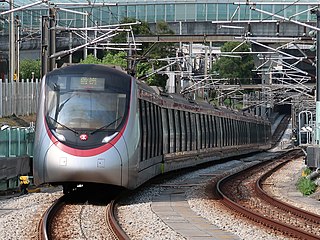
The Tuen Mun District is one of the 18 administrative districts of Hong Kong. As of 2021, it had a population of 506,879. Of these people, 64,000 are under the age of 18. Part of the district is the Tuen Mun New Town, which contains one of the largest residential areas in the New Territories.

Tsing Yi, sometimes referred to as Tsing Yi Island, is an island in the New Territories of Hong Kong, to the northwest of Hong Kong Island and south of Tsuen Wan. With an area of 10.69 km2 (4.13 sq mi), the island has been extended drastically by reclamation along almost all its natural shore and the annexation of Nga Ying Chau (牙鷹洲) and Chau Tsai. Three major bays or harbours, Tsing Yi Lagoon, Mun Tsai Tong, and Tsing Yi Bay (青衣灣) in the northeast, have been completely reclaimed for new towns.
Hong Kong counts approximately 600 temples, shrines and monasteries. While Buddhism and Christianity are the most widely practiced religions, most religions are represented in the Special Administrative Region.

The Light Rail, also known as the Light Rail Transit (LRT), officially the North-West Railway, is a light rail system in Hong Kong, serving the northwestern New Territories, within Tuen Mun District and Yuen Long District. The system operates over 1,435 mmstandard gauge track, using 750 V DC overhead power supply. It was once one of four systems comprising the KCR network in Hong Kong, before the MTR–KCR merger in 2007. It has a daily ridership of about 483,000 people. The line is color Deep Orange on the map.

Sheung Shui is an area in the New Territories, Hong Kong. Sheung Shui Town, a part of this area, is part of the Fanling–Sheung Shui New Town in the North District of Hong Kong. Fanling Town is to its southeast.

MTR Bus is a public non-franchised bus service in Hong Kong operated by the MTR Corporation, serving the northwestern part of the New Territories. It comprises a network of 22 feeder bus routes for the convenience of passengers using the MTR rapid transit network, providing access to and between many MTR stations on the Tuen Ma line and Light Rail.

Yuen Long is a town in the western New Territories, Hong Kong. To its west lie Hung Shui Kiu (洪水橋), Tin Shui Wai, Lau Fau Shan and Ha Tsuen, to the south Shap Pat Heung and Tai Tong, to the east Au Tau and Kam Tin (錦田), and to the north Nam Sang Wai.

Tuen Mun Ferry Pier (屯門碼頭), or Tuen Mun Ferry Terminal, is a public pier located in the southern area of Tuen Mun, Hong Kong.

Tuen Mun New Town, commonly referred to simply as Tuen Mun, is a satellite town of Hong Kong. It is one of the new towns that were developed by the Hong Kong Government in the New Territories from the 1960s. It was built around the existing rural local centre of Tuen Mun, which has since been referred to as the Tuen Mun Kau Hui and the Tuen Mun San Hui. The new town covers most of the urban area of Tuen Mun District.

Yuen Long Town is located in the district centre of Yuen Long District, New Territories, Hong Kong. It is the heart of Yuen Long and Yuen Long New Town, with a population of around 200,000.

Jordan Road Ferry Pier or Ferry Point (1924–1998) is a demolished pier originally located at Jordan Road, Jordan, Hong Kong.
Articles related to Hong Kong include:

The Tuen Ma line is a rapid transit line that forms part of the Mass Transit Railway (MTR) system in Hong Kong. Coloured brown on the map, the Tuen Ma line is 56.2 kilometres (34.9 mi) in length, making it the longest line of the MTR network. It has a total of 27 stations, more than any other in the MTR system.

Tuen Mun San Hui more commonly known as just San Hui (新墟) is an area of Tuen Mun District, Hong Kong and is a major food market and commercial quarter in the district. In urban planning, it is part of Tuen Mun New Town.

Yuen Long Kau Hui is an area in Yuen Long, Yuen Long District, in the western New Territories of Hong Kong.

Tin King Estate is a public housing estate in Tuen Mun, New Territories, Hong Kong. It is the tenth public housing estate in Tuen Mun, located near Light Rail Tin King stop, Leung King stop and San Wai stop. It consists of four residential buildings completed in 1989. The estate was formerly the site of Leung Tin Village and it was named from the village, together with the nearby Leung King Estate. Some of the flats were sold under Tenants Purchase Scheme Phase 2 in 1999.

The following is an overview of public housing estates in Tuen Mun, Hong Kong, including Home Ownership Scheme (HOS), Private Sector Participation Scheme (PSPS), Sandwich Class Housing Scheme (SCHS), Flat-for-Sale Scheme (FFSS), Subsidised Sale Flats Project (SSFP), and Tenants Purchase Scheme (TPS) estates.

Lung Kwu Tan is an area located in the western part of the Tuen Mun District in Hong Kong.

The Tuen Mun Rural Committee is a rural committee in Hong Kong. It was founded by rural leader Chan Yat-sen in 1953 with representatives from 29 villages in Tuen Mun. Today the rural committee consisted of 36 villages and 69 village representatives.

























